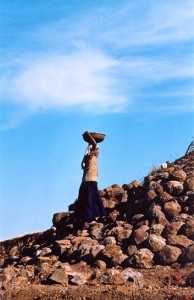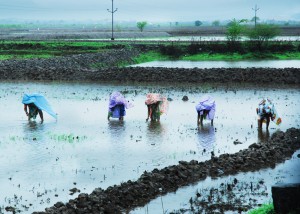A gender audit of the current budget, to assess whether gender commitments have been converted into budgetary commitments by the Government of India, reveals more shortcomings than successes.
By Vibhuti Patel
The Government of India introduced gender budgeting in 2004 to ensure that it’s policies and programmes actually receive the finances to make these commitments effective.
In the Union Budget 2012-13, Ministry of Women and Child Development has been allotted Rs.18500 crore (2012-13 Budget Estimate), an increase of 15 percent at current prices as compared to previous year’s Revised Estimate of Rs.16100crore (2011-12).
However, the total magnitude of the Gender Budget (outlays earmarked for women) had declined from 6.1 percent (2010-11 Budget Estimate) to 5.8 percent (2011-12 Revised Estimate). Though, there is a marginal increase of 0.1 percent in 2012-13 over the previous year.
The number of Union Government ministries/departments reporting in the Gender Budgeting Statement (a statement about budgetary allocations that has a bearing on women) has remained stagnant at 33 for the sixth consecutive year. Except for the Ministry of New and Renewable Energy, there is no new addition.
Inadequate finance
The Steering Committee on Women’s Agency and Empowerment for the 12th Plan had suggested several important interventions to address the gender based disadvantages experienced by girls and young and elderly women. For most of the existing schemes, the outlays are extremely low as compared to those proposed by this Committee. Despite 2012-13 being the first year of 12th Five Year Plan, allocations for schemes such as STEP, Hostels for Working Women and Priyadarshini, have registered only a marginal increase over the previous year.
The Ministry of Women and Child Development had launched the helpline for women, developed distance learning programme on women’s rights, and implemented Protection of Women from Domestic Violence Act, provided relief to and rehabilitation of rape victims. However the amount allocated for these schemes is grossly inadequate. There is also no financial allocation for Swayamsidha Phase II, for self-employed women and women entrepreneurs, which was considered by the 11th Plan as the main agency for women’s empowerment.
Most of the government flagship schemes continue to rely on underpaid labour of women. In the Budget 2012-13, while the role of Accredited Social Health Activist (ASHAs) – the backbone of the National Rural Health Mission (NRHM) has been enlarged, there is no mention by the Finance Minister to regularise their services. ASHAs will continue to get performance based remuneration on the targets they are able to fulfill.
The only saving grace in this budget is the effort by the Department of Science and Technology (DST), traditionally perceived as a male bastion. DST has launched several missions targeting women in order to promote women’s participation in scientific and technical fields,and to enhance women’s capabilities and choices. The new scheme of DST, ‘Disha’ in the Union budget 2012-13 is envisaged to facilitate the mobility of women scientists. There is an urgent need to replicate such efforts by other ministries based on practical and strategic gender needs of girls and women.
What Needs to be Done
For the past five years women’s groups have been demanding that the government review the format of the Gender Budgeting Statement but no progress has been made in this direction. Moreover the current budget has not addressed the long standing demands of women’s groups and gender economists with respect to budgetary allocation for;
Implementation of Pre Conception and Pre Natal Diagnostics Techniques (PCPNDT) Act. To halt the declining child sex ratio by judicious implementation of PCPNDT Act, 2002 so as to ensure stringent punishment to doctors and laboratory owners for abuse of sex determination and sex selection technologies
Implementation of Protection of Women from Domestic Violence Act, 2005.
Complete utilization of the 30% girls’ component within Sarva Shiksha Abhiyan and special budgetary allocation for public education and increased publicity drive in print and audio visual media.
Special financial allocation must be made for the salary of crèche teacher and helper in schools. In all schools, one room should be converted into crèche so that poor girls, who have younger siblings to look after, can leave them in the crèche and attend the classes. This would enhance retention rate of girls in the school.
Enhanced budgetary allocation for the Public Distribution System (PDS) in order to strengthen the provision of good quality of food grains, oil and soap to ensure better nutritional standards. Funds for community based mental health intervention must be promoted.
Enhanced funds for protection and rehabilitation of child workers and children in difficult circumstances such as street children, trafficked children. NGOs and community groups should be encouraged to provide ward wise update on status and data base on child labour in Mumbai.
Social security and social protection for women in the informal sector, Small Scale Industries, FTZs, EPZs, SEZs Construction workers, rag pickers, scavengers, food-processing industries, sweat shops and garment industry. Budgetary allocation for implementation of Unorganized Sector Social Security and Social Protection Act, 2008 is imperative.
Vocational Training Institutions must be provided to impart women skills in non-conventional areas so that they can get employment as taxi/bus drivers, plumbers, fitters, turners, electricians, carpenters, cobblers, so on and so forth.
Ensure access to information, finance, training and marketing for women entrepreneurs, SHGs, vendors and self employed women. Women entrepreneurs and traders must be given priority while allotting shops by public sector corporations and local government.
Budget for Crèche facilities, working women’s hostels and short stay homes must be enhanced many folds.
For making India disabled friendly a detailed data base must be prepared on types of disability and number of people who are physically challenged.
Construct night shelters with toilets and baths for homeless women and girls with the help of centrally sponsored schemes as well as state financial allocation.
Community based half way homes, working women’s hostels and multi-purpose activity center to meet variety of needs of women and girls. Half way homes and counselling centers must be created to address problems faced by elderly women and women who are physically challenged.
Support in the area of education, health; housing and skill development must be provided to women headed households (FHHs)
Generate Gender Disaggregated Data to address strategic gender needs and practical gender needs of women in Mumbai.
Affirmative action to protect interests of women in difficult circumstances such as child prostitutes, homeless women, street girls, abducted girls, child brides, women suffering from HIV/AIDS, single women and elderly women.
Safe transport in terms of women special buses and local trains
Well maintained Public toilets for women.
Informal Sector
Considering women’s central role to the care economy, and the large numbers of women in unpaid work, policies need to focus on social services to support women’s care roles (old age, child care) and adequate resource allocations need to be made to support them.
Rural Sector
In the light of the present agrarian crisis and food insecurity the vulnerability of women farmers in particular needs attention. Women’s access to land needs to be strengthened immediately considering the huge gender disparities in land ownership patterns. This could be done by;
(a) Improving women’s claims to family land (b) Improving access to public land by ensuring that all land transfers for poverty alleviation, resettlement schemes, etc., recognize women’s claims (c) Improving women’s access to land via market through provision of subsidized credit to poor and by encouraging group formation for land purchase or lease by poor women.
Conclusion
Women’s rights organizations in India have demanded that the Government should ensure adequate gender budgeting in all ministries and departments, enact a comprehensive Food Security Bill, ensure universal PDS as a core component, allocate 6% of GDP for Health, allocate 6% of GDP for Education, make budgetary allocation to cover special schemes for women workers, increase allocation for women farmers, enhance resource allocation for tribal, dalit, and minority women and increase budgetary support for schemes to assist women-headed households and differently abled women.
In the absence of sex disaggregated data, evaluation of schemes through a gender lens or any effort at strengthening gender dimensions of existing schemes poses a big question. So, provision of such data should be prioritized.
The target of 30% gender allocations under all ministries has not yet been achieved. This must be implemented immediately. There is a crying need for a gender audit and gender outcome appraisal of all ministries and departments at the central and state levels. Very often, resource allocations made under gender budgeting do not reach in time and they remain unspent. There should be proper monitoring and supervision of the allocated funds with greater transparency and accountability at all levels.
Vibhuti Patel is active in the women’s movement in India since 1972 and currently teaching at SNDT women’s University, Mumbai.

